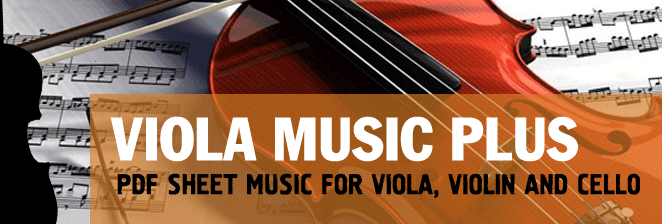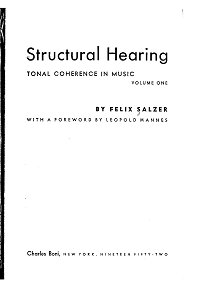|
|
 |
|
| |
| |
|
Felix Salzer - Structural Hearing (Tonal coherence in music) Book 1 |
Felix Salzer - Structural Hearing (Tonal coherence in music) Book 1
Felix Salzer - Structural Hearing (Tonal coherence in music) Book 1. You can download the PDF sheet music Felix Salzer - Structural Hearing (Tonal coherence in music) Book 1 on this page. This book is based on Heinrich Schenker's revolutionary conceptions of tonality and musical coherence. It has been motivated and guided by my great admiration for Schenker himself, as well as by my gratitude for those ideas and teachings which have given my musical life its purpose and direction.
It is not the aim of this book to apply Schenker's ideas to specific problems; this has already been done in books in both English and German. My purpose is to mold his concepts into a workable, systematic approach for use by teachers, students and performers, as well as by anyone seriously interested in the problems of musical continuity, coherence and structure.
In planning the contents of this book it seemed necessary first to explain in outline the essence of his ideas and their vital significance for our times. I have therefore divided the book into three parts which differ somewhat in approach. The first part presents Schenker's conceptions, their purpose and the possibilities which they suggest. It is in no sense intended as a comprehensive survey but simply as an introduction to the fundamental ideas upon which the approach is based. The questions raised by the first part and many which it leaves | untouched, will be answered in the second part—The pedagogic and systematic approach to structural hecrring. Each of these parts, however, will be treated as a unit, each understandable and complete in itself, without reference to the other. This procedure necessarily entails a certain amount of repetition, especially between Chapter II of Part I and the early chapters of Part II. Such repetition is unavoidable if the second part is to be presented as a complete and detailed exposition of the approach. In addition, it can serve only to enhance the reader's understanding to find each idea, which served in the general outline, repeated and developed in its exact perspective within the detailed whole. The third part, finally, deals with the implications and consequcnces of structural hearing as they concern problems of musical understanding, interpretation and musicology.
To download PDF, click the "Download PDF" button below the appropriate sheet music image.
To view the first page of Felix Salzer - Structural Hearing (Tonal coherence in music) Book 1 click the music sheet image. |
PDF format
|
|
|
|
Book: 312 pages. 77587 K
|
|
 |
{ |
|
|
| Download PDF (14.99
€) |
|
|
Whoever undertakes the task of presenting Schenker's ideas outside the German-speaking world is confronted with the formidable question: "Why not translate Schenker's writings and let them speak for themselves?" There were many reasons for my decision to drop the idea of translation, with or without commentary. One important reason seemed to me to be the very gradual, yet at the same time very complex, manner in which Schenker's final conceptions took shape. Between the harmony book, published in 1906, and the final work, Der freie Satz, published after his death in 1935, his books and articles reveal the extraordinary growth of his ideas. However, to the musician still unfamiliar with his work, these publications do not present a systematic development from rudimentary ideas to their final form and definition. For instance, there seems to be a veritable break between the period in which he wrote his study of Beethoven's Ninth Symphony I (1912) and that in which the first issue of Der Toniville (1921) was published. New ideas suddenly appear, seemingly for the first time, and the gap between these two periods has never been explained. From then on, the development of the new ideas is more consistent; but although the bridge from old to new is understandable to one familiar with Schenker's approach, it presents a definite obstacle for the beginner. Even in the years between 1920 and 1935 various major changes both in the conception and in the working-out of ideas are evident in the various issues of Der Toniville as well as in the three volumes of Das Meisteriverk in der Musik; the reasons for these were never fully revealed. Although Schenker's students and others sufficiently interested in his work were able to follow his provocative and compelling way of thinking and reasoning (and were able in turn to give their students the necessary explanations), the fact remains that Schenker's last work, Der freie Satz, is a highly advanced and rather complex book for which adequate preparation simply does not exist.
These factors made translation, without at least a thorough and lengthy commentary, highly inadvisable. But there were two other decisive reasons that finally caused me to give up any idea of translation and to write a new book presenting his conceptions systematically. During the years following Schenker's death (January, 1935), partly as a result of discussions with other musicians and teachers but mainly through my own teaching experience, one thought became increasingly clear. To teach music theory, analysis and composition according to his ideas, it was necessary to formulate a new pedagogic approach to these ideas.' Many points required clarification, and many terms needed more concise definitions; it became apparent, furthermore, that explanations ought to begin on a more elementary level. Understanding of tonal organisms is a problem of hearing; the ear has to be systematically trained to hear not only the succession of tones, melodic lines and chord progressions but also their structural significance and coherence. Thus a systematic approach evolved, starting from simple and short examples and leading, in gradual stages, to large and complex organisms. This approach I call "Structural Hearing."
The second reason for not translating is that Schenker, with very few exceptions, used as illustrations music of the eighteenth and nineteenth centuries only, the music which lay so close to his heart and mind. Within the last fifteen years I have become completely convinced, however, that his ideas apply to widely diverse styles of music and that the broad conception underlying his approach is not confined to any limited period of music history. This fact has not been recognized sufficiently and has led to the belief that Schenker's writings are valuable only for eighteenth- and nineteenth-century music. Nothing could be more erroneous; it is hoped that the following pages will prove the fallacy of this contention.
Hence Schenker's basic premises are left untouched in this book, but within the new pedagogic approach, several definitions have been revised and the range of literature has been considerably widened. I am aware of the fact that these changes will be criticized by those who still cling with the spirit of orthodoxy to every word Schenker has pronounced and who oppose any deviation from or any development of his writings. I consider this attitude narrow-minded and short-sighted. It has proven to be detrimental to the dissemination of the approach as a whole, because, by its very dogmatism, it has tended to make hard and fast some misunderstandings to which Schenker's writings have been subjected. I am convinced that a free and unbiased investigation of his work, while making certain definite modifications necessary, shows its value as even greater and farther reaching than heretofore held possible. It seems to me that Schenker's concepts provide not only for an intimate understanding of musical architecture of the past centuries, but, once thoroughly understood, may contribute towards establishing a truly modern style of composition. |
|
|
|
|
| |
|
|
| |
|
|
|
|